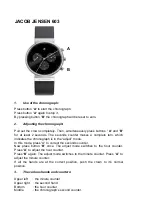
24
Heart Rate Features
No Status:
The device needs one or two weeks of training
history, including activities with VO2 max. results from
running or cycling, to determine your training status.
Tips for Getting Your Training Status
The training status feature depends on updated assessments
of your fitness level, including at least two VO2 max.
measurements per week. Your VO2 max. estimate is updated
after outdoor runs or rides with power during which your
heart rate reached at least 70% of your maximum heart rate
for several minutes. The trail run and indoor run activities do
not generate a VO2 max. estimate in order to preserve the
accuracy of your fitness level trend.
To get the most out of the training status feature, you can try
these tips.
At least two times per week, run or ride outdoors with
a power meter, and reach a heart rate higher than 70%
of your maximum heart rate for at least 10 minutes.
After using the device for one week, your training
status should be available.
Record all of your fitness activities on this device, or
enable the Physio TrueUp feature, allowing your
device to learn about your performance (
Activities and Performance Measurements, page 20
Training Load
Training load is a measurement of your training volume
over the last seven days. It is the sum of your excess post-
exercise oxygen consumption (EPOC) measurements for
the last seven days. The gauge indicates whether your
current load is low, high, or within the optimal range to
maintain or improve your fitness level. The optimal range
is determined based on your individual fitness level and
training history.
The range adjusts as your training time and intensity
increase or decrease.
Training Load Focus
In order to maximize performance and fitness gains, training
should be distributed across three categories: low aerobic,
high aerobic, and anaerobic. Training load focus shows you
how much of your training
is currently in each category and provides training
targets. Training load focus requires at least 7 days of
training to determine if your training load is low, optimal,
or high. After 4 weeks of training history, your training
load estimate will have more detailed target information
to help you balance your training activities.
Below targets:
Your training load is lower than optimal in all
intensity categories. Try increasing the duration or
frequency of your workouts.
Low aerobic shortage:
Try adding more low aerobic
activities to provide recovery and balance for your
higher intensity activities.
High aerobic shortage:
Try adding more high aerobic
activities to help improve your lactate threshold and
VO2 max. over time.
Anaerobic shortage:
Try adding a few more intense,
anaerobic activities to improve your speed and
anaerobic capacity over time.
Balanced:
Your training load is balanced and provides all-
around fitness benefits as you continue training.
Low aerobic focus:
Your training load is mostly low
aerobic activity. This provides a solid foundation and
prepares you for adding more intense workouts.
High aerobic focus:
Your training load is mostly high
aerobic activity. These activities help to improve
lactate threshold, VO2 max., and endurance.
Anaerobic focus:
Your training load is mostly intense
activity. This leads to rapid fitness gains, but should be
balanced with low aerobic activities.
Above targets:
Your training load is higher than optimal,
and you should consider scaling back the duration and
frequency of your workouts.
Recovery Time
You can use your Garmin device with wrist-based heart
rate or a compatible chest heart rate monitor to display how
much time remains before you are fully recovered and
ready for the next hard workout.
NOTE:
The recovery time recommendation uses your VO2
max. estimate and may seem inaccurate at first. The device
requires you to complete a few activities to learn about your
performance.
The recovery time appears immediately following an
activity. The time counts down until it is optimal for you
to attempt another hard workout. The device
updates your recovery time throughout the day based on
changes in sleep, stress, relaxation, and physical activity.
Viewing Your Recovery Time
For the most accurate estimate, complete the user profile
setup (
Setting Up Your User Profile, page 11
), and set your
maximum heart rate (
Setting Your Heart Rate Zones, page
1
Go for a run.
2
After your run, select
Save
.
The recovery time appears. The maximum time is 4
days.
NOTE:
From the watch face, you can select UP or
DOWN to view the training status widget, and
select START to scroll through the metrics to view your
recovery time.
Recovery Heart Rate
If you are training with wrist-based heart rate or a
compatible chest heart rate monitor, you can check your
recovery heart rate value after each activity.
















































